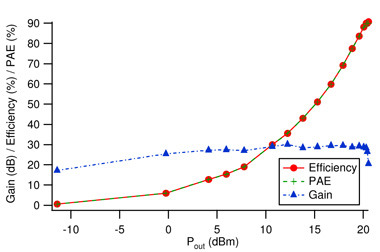
| Home | About Us | Contribute | Bookstore | Advertising | Subscribe for Free NOW! |
| News Archive | Features | Events | Recruitment | Directory |
News
2 July 2010
Record 90% efficiency achieved using commercial GaAs RF devices
Mesuro Ltd of Cardiff, UK, which is commercializing RF test & measurement technologies from Cardiff University’s Centre for High Frequency Engineering, says that it has achieved record efficiencies in joint work with device manufacturers to design harmonically tuned, near theoretically efficient power amplifiers (PAs) with existing RF transistor technologies.
The ability to achieve near-theoretical efficiencies requires accurate harmonic tuning. Mesuro’s active tuning capability can be applied to both the source and load side of a device and allows complete control of all in-band and out-of-band impedances. In association with device maker TriQuint Semiconductor Inc of Hillsboro, OR, USA, Mesuro has now made available results showing a commercial GaAs pHEMT device achieving efficiencies in excess of 90% at P1dB in a class-B bias.
According to band-limited theory, efficiencies of more than about 80% for engineered 3 harmonic content should not be possible with this type of device. However, much higher efficiencies than this were achieved in this work.

From the device measurements undertaken, it was clear that the harmonic current levels were dependent on both drive level and input bias, says Mesuro. The firm adds that this data set is invaluable to power amplifier designers, who then have the necessary information available to them to achieve optimum design goals. Using Mesuro's technique to extract near-theoretical-best performance from the RF power transistor delivers best-in-class efficiency as a baseline, it is claimed. If desired, amplifier design enhancement techniques such as envelope tracking or Doherty could then be applied to provide nominal incremental amplifier efficiency improvements.
“These results continue to demonstrate the value of active harmonic load-pull techniques and how they can be applied to improve existing designs, in addition to developing new products,” says Mesuro’s CEO Dr Richard Emsley. “The next stage is to take this data and fabricate a MMIC (monolithic microwave IC) design in order to further show how the Mesuro solution can aid reducing design cycles and achieve ‘first-pass’ amplifier designs,” he adds.
“The fundamental development process for radio frequency components and devices has not changed in the last three decades – until now... By using Mesuro’s waveform engineering techniques, our customers have a 100% success rate for improving their PA efficiencies and performance,” Emsley claims.
A white paper ‘Investigation and Analysis into Device Optimization for Attaining Efficiencies In-Excess of 90% When Accounting for Higher Harmonics’ can be found on Mesuro’s website.
![]() Search: GaAs pHEMT
Search: GaAs pHEMT
Visit: www.mesuro.com